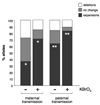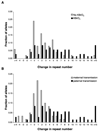Potassium bromate, a potent DNA oxidizing agent, exacerbates germline repeat expansion in a fragile X premutation mouse model
- PMID: 20213777
- PMCID: PMC2951473
- DOI: 10.1002/humu.21237
Potassium bromate, a potent DNA oxidizing agent, exacerbates germline repeat expansion in a fragile X premutation mouse model
Abstract
Tandem repeat expansion is responsible for the Repeat Expansion Diseases, a group of human genetic disorders that includes Fragile X syndrome (FXS). FXS results from expansion of a premutation (PM) allele having 55-200 CGG.CCG-repeats in the 5' UTR of the FMR1 gene. The mechanism of expansion is unknown. We have treated FX PM mice with potassium bromate (KBrO(3)), a potent DNA oxidizing agent. We then monitored the germline and somatic expansion frequency in the progeny of these animals. We show here that KBrO(3) increased both the level of 8-oxoG in the oocytes of treated animals and the germline expansion frequency. Our data thus suggest that oxidative damage may be a factor that could affect expansion risk in humans.
Published 2010 Wiley-Liss, Inc.
Figures



Similar articles
-
Mechanisms of Genome Instability in the Fragile X-Related Disorders.Genes (Basel). 2021 Oct 17;12(10):1633. doi: 10.3390/genes12101633. Genes (Basel). 2021. PMID: 34681027 Free PMC article. Review.
-
The transcription-coupled repair protein ERCC6/CSB also protects against repeat expansion in a mouse model of the fragile X premutation.Hum Mutat. 2015 Apr;36(4):482-7. doi: 10.1002/humu.22777. Hum Mutat. 2015. PMID: 25726753 Free PMC article.
-
Transcriptomic profiling of unmethylated full mutation carriers implicates TET3 in FMR1 CGG repeat expansion methylation dynamics in fragile X syndrome.J Neurodev Disord. 2025 Apr 26;17(1):22. doi: 10.1186/s11689-025-09609-5. J Neurodev Disord. 2025. PMID: 40287634 Free PMC article.
-
Immune dysregulation as a cause of autoinflammation in fragile X premutation carriers: link between FMRI CGG repeat number and decreased cytokine responses.PLoS One. 2014 Apr 9;9(4):e94475. doi: 10.1371/journal.pone.0094475. eCollection 2014. PLoS One. 2014. PMID: 24718368 Free PMC article.
-
[FMR1 PREMUTATION CARRIERS - ARE THEY REALLY ASYMPTOMATIC?].Harefuah. 2018 Apr;157(4):241-244. Harefuah. 2018. PMID: 29688643 Review. Hebrew.
Cited by
-
AGG interruptions within the maternal FMR1 gene reduce the risk of offspring with fragile X syndrome.Genet Med. 2012 Aug;14(8):729-36. doi: 10.1038/gim.2012.34. Epub 2012 Apr 12. Genet Med. 2012. PMID: 22498846 Free PMC article.
-
X inactivation plays a major role in the gender bias in somatic expansion in a mouse model of the fragile X-related disorders: implications for the mechanism of repeat expansion.Hum Mol Genet. 2014 Sep 15;23(18):4985-94. doi: 10.1093/hmg/ddu213. Epub 2014 May 8. Hum Mol Genet. 2014. PMID: 24858908 Free PMC article.
-
Biological properties of Alsidium corallinum and its potential protective effects against damage caused by potassium bromate in the mouse liver.Environ Sci Pollut Res Int. 2016 Feb;23(4):3809-23. doi: 10.1007/s11356-015-5620-2. Epub 2015 Oct 24. Environ Sci Pollut Res Int. 2016. PMID: 26498820
-
Modulation of trinucleotide repeat instability by DNA polymerase β polymorphic variant R137Q.PLoS One. 2017 May 5;12(5):e0177299. doi: 10.1371/journal.pone.0177299. eCollection 2017. PLoS One. 2017. PMID: 28475635 Free PMC article.
-
DNA base excision repair: a mechanism of trinucleotide repeat expansion.Trends Biochem Sci. 2012 Apr;37(4):162-72. doi: 10.1016/j.tibs.2011.12.002. Epub 2012 Jan 27. Trends Biochem Sci. 2012. PMID: 22285516 Free PMC article. Review.
References
-
- Awogi T, Murata K, Uejima M, Kuwahara T, Asanami S, Shimono K, Morita T. Induction of micronucleated reticulocytes by potassium bromate and potassium chromate in CD-1 male mice. Mutat Res. 1992;278(2–3):181–185. - PubMed
-
- Ballmaier D, Epe B. DNA damage by bromate: mechanism and consequences. Toxicology. 2006;221(2–3):166–171. - PubMed
-
- Barlow C, Hirotsune S, Paylor R, Liyanage M, Eckhaus M, Collins F, Shiloh Y, Crawley JN, Ried T, Tagle D, et al. Atm-deficient mice: a paradigm of ataxia telangiectasia. Cell. 1996;86(1):159–171. - PubMed
-
- Berghorn KA, Bonnett JH, Hoffman GE. cFos immunoreactivity is enhanced with biotin amplification. J Histochem Cytochem. 1994;42(12):1635–1642. - PubMed
Publication types
MeSH terms
Substances
Grants and funding
LinkOut - more resources
Full Text Sources
Medical

